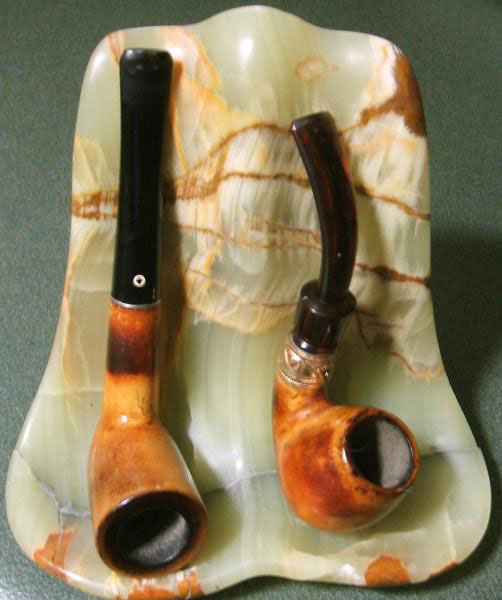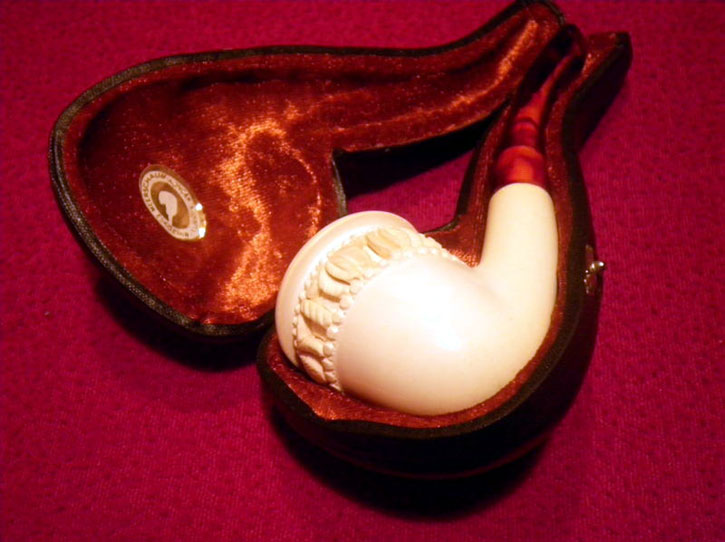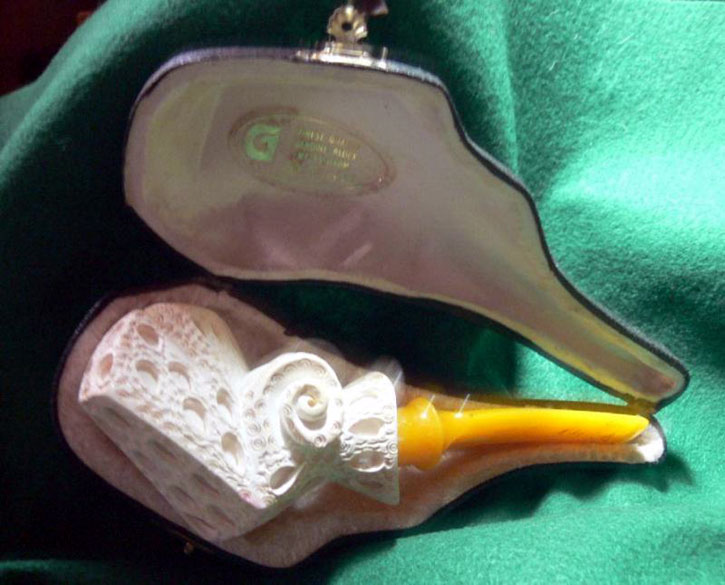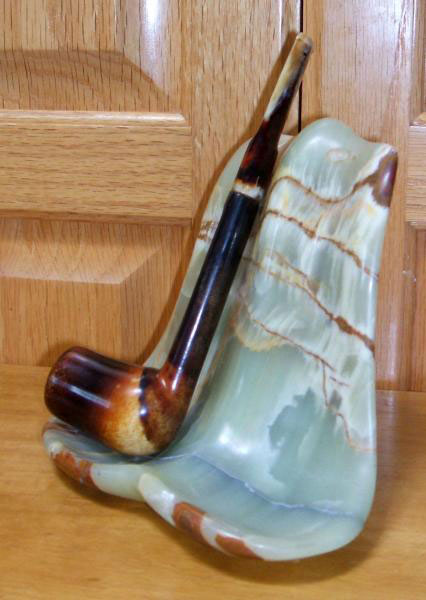Fred Bass

Estate Meerschaums cross oceans of time in their lifetime of service for those lucky enough to smoke them. In a market where the buyer can find himself at odds with the skill, judgment, and honesty of the seller, the seller is sometimes found lacking in these qualities, and may be the victim of yet an older fraud himself. The current hazards to the buyer in the meerschaum market are not new in origin, as deception has been a common practice for hundreds of years; hence the term Meer-sham continues to have credence. It is to the buyer’s benefit to pursue an education, to learn about vintage or antique meerschaums in order to avoid the more expensive results: buyer’s remorse. The rewards of a successful acquisition are many and certainly worth the risk. Vintage (a general guide is less than 100 years old) and antique (more than 100 years old) meerschaums have gained seasoned perspectives by lessons from fire and tobacco that are simply not found in the new pipes. This is one of the reasons that I’m active in the estate meerschaum marketplace as a buyer who seeks the virtues that these old soldiers have to offer. The smoking qualities and advanced patina of these pipes are also the primary source of distraction to those who haven’t done their homework but continue to look for bargains, e.g., that overlooked Andreas Bauer.
Joaquin Verdanguer makes an amusing note of market manipulation in his book, The Art of Pipe Smoking, (The Curlew Press Limited, 1958, 28-29):
Until 1850 meerschaums were made exclusively in Austria. Then the French butted in, boastfully advertising their wares as ‘French meerschaums’ and selling them by the thousands. That would have been all right if they hadn’t played a dirty trick on their competitors. Out of the shavings and other by-products they manufactured pipes of inferior quality and slyly marketed them under the trade-mark ‘Made in Austria’. Consequently this label was so discredited that a Viennese pipe dealer showing a prospective buyer a truly magnificent meerschaum and saying to him ‘A genuine Austrian product, sir!’ was bewildered when the customer would mutter ‘confounded racket’ and then stalk out of the shop.
The modern day version of this drama are the Turkish exports labeled “Made in Vienna”, a remarkable feat, considering that the Turkish government passed a law in 1961 banning the export of raw meerschaum block (Jean Rebeyrolles, Collectible Pipes, 2002). Prime indicators that should arouse a degree of suspicion include the use of the “925” designation for silver, instead of “sterling”; Delrin push-pull connectors of recent manufacture; claims of “real amber” or “cultured amber” in bit construction, when plastic has been used; and pipe cases of recent manufacture. It is wise to note that other concerns exist for the potential buyer. For example, this looks like the site that Sedat Koncak shut down about 5 years ago, advertising both Andreas Bauer & Koncak pipes. It would be prudent to exercise caution and be certain as to the legitimacy of the seller, prior to making payment. http://koncak.sarslan.com/Koncak/advice.htm. Currently, the trademark for Andreas Bauer meerschaums is held by Kopp GmbH & Co. KG. These meerschaum pipes are available thru authorized dealers in Europe at prices ranging from 215 Euros to 350 Euros, depending on the shape and size of the pipe. I suspect they are commissioned pipes made by IMP, owned by Mustafa Albayrak. IMP is Ihrac Mallari Pazarlama, Turkish for Import and Export Marketing. Chances are that if the pipe is a Dunhill, or a Peterson Turkish block meerschaum or a new or vintage Andreas Bauer meerschaum, then it was likely made in Turkey by IMP, Altinay or Koncak as either a contract commissioned order or by the unauthorized use of a patent trademark. This is speculation on my part, as none of my inquiries to these companies have been answered. Trade secrets are closely guarded today, as they have been in the past within the meerschaum trades.
There is yet another dimension of counterfeit that has continued rather unabated – the use of epoxy (or resin) material in the manufacture of replica pipes, which is much denser than meerschaum. In the 1970s, there was a man in Massachusetts, who made molds from his own antique meerschaum pipes and cheroot holders, replicated them in resin and sold them as meerschaum-like objects. He designed the card stock on which these pipes were displayed, advertising them by a name he coined, “Hydrostone.” These pipes are still around today, and will occasionally show up in the marketplace. This is a case of caveat emptor and caveat vendor. Clues to this fake often appear as unusual proportions of the pipe’s shank and the use of push-pull connectors that are supposedly from the Victorian era. Since that time, the following believed-to-be resin motifs have appeared at auctions, at pipe shows, and on e-bay: (1) the “Nude Victory,” a woman on the front of a tulip-shaped bowl, her arms outstretched over her head; (2) “Woman and Child,” two of which were recently offered on e-bay, one in the US and one in the UK, whose shank configuration and push stem are most unusual for an “antique” meerschaum pipe, and most recently (3) the bust of a Norseman or Viking, whose telltale signs of new-age construction are a latticed pot-metal shank band and an orange plastic mouthpiece, both characteristics reminiscent of the exact same components of the pipe reported in Rapaport’s, Collecting Antique Meerschaums. What is not known is whether the sellers of these pipes are doing so wittingly or whether they are unaware of or unfamiliar with what they offer. Until further discovery–if discovery ever occurs–it is best that caveat emptor and “being forewarned is being forearmed” be the watchwords to buyers. I have even seen one that appeared as though someone had attempted to smoke it. I can only imagine what that experience must have been like. The first formal notification of such skullduggery appeared in Rapaport’s book, in which he identified a reproduction in resin best described as a blood-red pre-colored motif of a man carousing with several girls, supposedly signed by Gustav Fisher (an incorrect spelling of someone who never signed his pipes), a pot metal shank band and an orange plastic mouthpiece. Even so, resin counterfeits continue to show up in auctions and sales. One American collector owns at least six of these replica pipes that were offered for sale in various venues from as little as $100 to as much as $600.

Another example can be found in the case of similar circumstance with a seller in Nottingham, England. A noted American collector had this to say:
John Lee, from the United Kingdom, was an individual who reproduced antique meerschaum pipes. He made them out an epoxy. His main claim to fame was in working on old palatial estates including what he called some small castles. He would reproduce and repair items from the days of old, including fire places, walls, etc. He did reproduce some meerschaum pipe designs (about 40), as a hobby and sold hundreds. He advised that he never said that the pieces were of meerschaum or that they were antique. John Lee was seen as friendly, helpful, honorable and very concerned about his product being misrepresented. He said that the weight and texture would be dead giveaways as to the pieces not being meerschaum. This American collector told John that some of the buyers were selling these replicas on the Internet as meerschaum and he was upset with this. He did not wish for anyone to get hurt… He either stopped due to illness, age or found something else to do. John was known as being kind and polite in dealing with those he knew. He must be in his 80’s, if he’s still alive. He made a video for a show, talking about how he did this type of molding. He sent this American collector five of his style of pipe reproductions. In one of their last conversations 6 years ago, John invited this collector to send him any meerschaum pipe; of any length or style and that he could reproduce it, even three dimensional. John was also an artist. He sent this collector a painting that he did of a falcon. He loved falcons and had one. 6 years ago, John was helping another collector with a resin base to make large replica amber stems. They worked on the color. The only problem that they had with the stems was that after bending the stem it would straighten out and had to be re-bent. They eventually got the problem corrected.
Today there are 4,125 listings under a general search for “meerschaum” on e-Bay alone, which is a steady indicator of the continued and increasing interest of both buyers and sellers for new, vintage and antique meerschaums. This is a huge opportunity and challenge for the collector. For the most part, my interests are confined to the new and vintage pipes for smoking. What little understanding I have of the antique pipe market comes from my association and friendship with Ben Rapaport, whose efforts to research and publish articles about these pipes carved from about 1850 to 1925 have been a major influence for decades. It is worth mentioning that potential buyers in the antique meerschaum market would do well to read João P. Martins’ Meerschaum Pipes @ E-Bay (1999-2010) available at http://www.blurb.com/bookstore/detail/1545260. Ben’s review of this book is: “As a long-time pipe collector and author of six books on the subject of antique pipes, it is my professional and personal opinion that Joao Martins has made a significant contribution to this hobby by filling in the gaps and voids with current-market prices for these rare objects of art … No prior book in any language has accomplished this feat: a ready reference to what’s hot, what’s not, and what people are paying for these collectible meerschaum pipes.” I quote this because it is good to know the difference between antique and vintage pipes—which seems to be a point of ignorance for many sellers.

Just as these old frauds continue to circulate, there are new ones to contend with as well. Shallow mines yield low quality block and no amount of skill or artistic merit will overcome the poor smoking qualities and patina development from pipes produced using low grade materials. New pipes priced exceptionally low in relation to what else you see being offered for sale should trigger a cautious response and an inquiry should be made to the seller prior to bidding. Whether I’m looking for a masterpiece of craftsmanship or a simple pipe that will give good service, clear dialogue with the seller is a deal maker/breaker for me. Comprehensive and accurate photography better aids the seller for a quick sale, at a higher price than out-of-focus, blurred images that some use to disguise pipes made of clay, Plaster of Paris, resin, pressed or formed block, some of which are not that easy to distinguish from natural block. Sometimes, you will have the opportunity to inspect estate and vintage pipes firsthand, but most of the time you will just have photos to work from. Generally, I avoid sellers who do not accept returns and I pay attention to what previous buyers have to say about past experiences.

The high value that many place on advanced coloration in a meerschaum gives incentive to shortcuts employed by some sellers. Pipes colored in smoke jars will have a dull appearance without depth and exhibit a darker color in the places that usually show the least amount of color in pipes that have been smoked and waxed. Some re-sellers will use their own wax finishes that give the appearance of color, but it usually turns out to be spotty and uneven. I’ve seen pipes that had been stained with pigment or dye, and ones that were boiled in tobacco stew or dark tea; tea can stain (and age) new ivory, so imagine tea’s effect on porous meerschaum. It would be advisable to become well-schooled in these arcania before paying for knowledge acquired thru poor purchase decisions. Cultivating an eye for general condition and repair of used estate pipes is advisable. Pipe repair and restoration is a big topic in itself but it should be mentioned here, since it needs to be taken into account as part of a wise purchase decision. If you are determined to acquire a pipe that has been abused for decades, be prepared to make it a years-long project of care and cleaning. I have taken in pipes that required drilling out the chamber and draft to remove years of cake build up. The results of careless handling and neglect can be addressed but can easily require years to do so. After sanding the exterior with progressively finer grades of micro mesh in an Everclear bath, re-waxing the block and spending a few hours cleaning the bit, it still took years of smoking, waxing and routine cleaning for the pipe to smoke with clarity and the patina to return. These pipes have been worth the effort involved in getting them back on their evolutionary path. It’s not so bad when the previous owner was a Virginia smoker, but cheap Aromatics will ghost a pipe for longer than you ever thought possible. Cleaning up these pipes is a labor of love as you don’t have the option of using a salt/alcohol treatment or the use of a retort, like you can with a Briar. Repair is another issue that should be taken into account, as it can cost more to have the pipe fixed than it did to purchase it, unless you have the skills, materials and equipment to apply to this end.

In writing these considerations to give the potential buyer information about the estate meerschaum pipe market, it’s my hope that these perspectives and experiences will serve the reader in future purchase decisions. The large body of books, articles and essays available afford those who wish to learn the opportunity to do so. The challenge is to find good information to serve as the basis for wise decisions beyond what is available from general hearsay and myth that is common to so many public discussions, groups, forums and poorly researched literature. Whether you’re looking for pipes that will provide you with good service within the limitations of a small budget or seeking high end collectables, the opportunity to find both never has been greater. In this context, it is good to remember never to underestimate the desire of a pipe seller to earn your purchase. For me, the thrill of the hunt is big part of the fun in acquiring these gems, and increases my appreciation of them during the smoke, as well as their display. A few years ago, it would not have been something that I thought might be for me. Now a significant part of my collection includes estate pipes. Cleaning them up & repairing them has given new dimension to the pleasures of pipe smoking. May your hunting be successful and bring the pleasures of these pipes to you as well.

Read more of Fred’s expert articles on meerschaum pipes at the following links –
–The Meerschaum Pipe Experience
–The Thrill of the Hunt (A Guide to Estate Meerschaums)
–Slave to the White Goddess
|
Fred Bass is the founder of the “All Things Meerschaum Group” on Smoker’s Forums. All but one of the pipes shown in this article are from his collection. You can see more of Fred’s Meerschaum Pipe Collection in his Pipe Photo Album, which includes close to 100 pipes. |


















A fine article by a true gentleman and pillar of the online pipe smokers’ community. One of Fred’s posts got me to buy my first Meer. I now have a no-name Turkish skull, a Baki apple, a Peterson system African block, and an Isle of Man African Block billiard. Great job Fred, thank you!
What can I say? You da man, Fred! Valuable information to fellow and future devotees of the White Goddess!
Great information Fred, well done!
Fred’s artiicles have always been very helpful. Thannks again for posting. I never thought to be so cautious with eBay meerschaum sales.
Thanks guys..!! This one was fun to write and hopefully
fun to read as well. After a couple of years of the Muse’s
absence, she has been giving me frequent inspiration to write again. Now, I have the challenge to find the time to do little else… She doesn’t keep regular hours, and there are more to publish as long as people continue to enjoy reading them.
Fred, thanks for expanding the pipe smoker’s information resources with this excellent article. It exposes aspects of the meerschaum market that few of us were aware of, and the timely heads-up is much appreciated.
Good article.Regarding the hydrostone pipes,it may be helpfull to check their advertisement page on pipe smoker magazine.They show their models so they are easier to spot in an auction picture.I have not seen them oftenly on ebay but sometimes they appear.So good that you mentioned Ben Rapaport.For anyone interested in meerschaum pipes,Ben’s books are a must.They are full of valuable information.I highly recommend those books.
It’s kind of crazy that this rock comes from so few places on earth. Is there no quality Meerschaum anywhere else?
I inherited an antique Meerschaum Pipe that belonged to my Grt Grt Grand Father in Germany. Must be 150+yrs old as far as I can tell. What is the best way to appraise and sell it to someone who collects and appreciates this type of antique?
Intricate carved figurehead. Very Yellowish,
Contact a collector of fine antique meerschaum pipes and he will be happy to appraise or purchase your pipe. I am one of those collectors should you be interested.
Hello, My name is Michael. I’m 24. I’ve been smoking pipes for roughly seven years, though I knew nothing about them until more recently. I have a Butz Choquin St. Claude bulldog. I literally hate this pipe but now it’s the only one I have after an ex of mine stole my favorite bent dublin Stanwell. I’m looking to get rid of the butz choquin and purchace a new pipe. I think I might need a little help and direction, I know what I like but I still have many questions.